Optimization and Comparison of Five Methods for Extraction of Coniferyl Ferulate from Angelica sinensis
Abstract
:Introduction
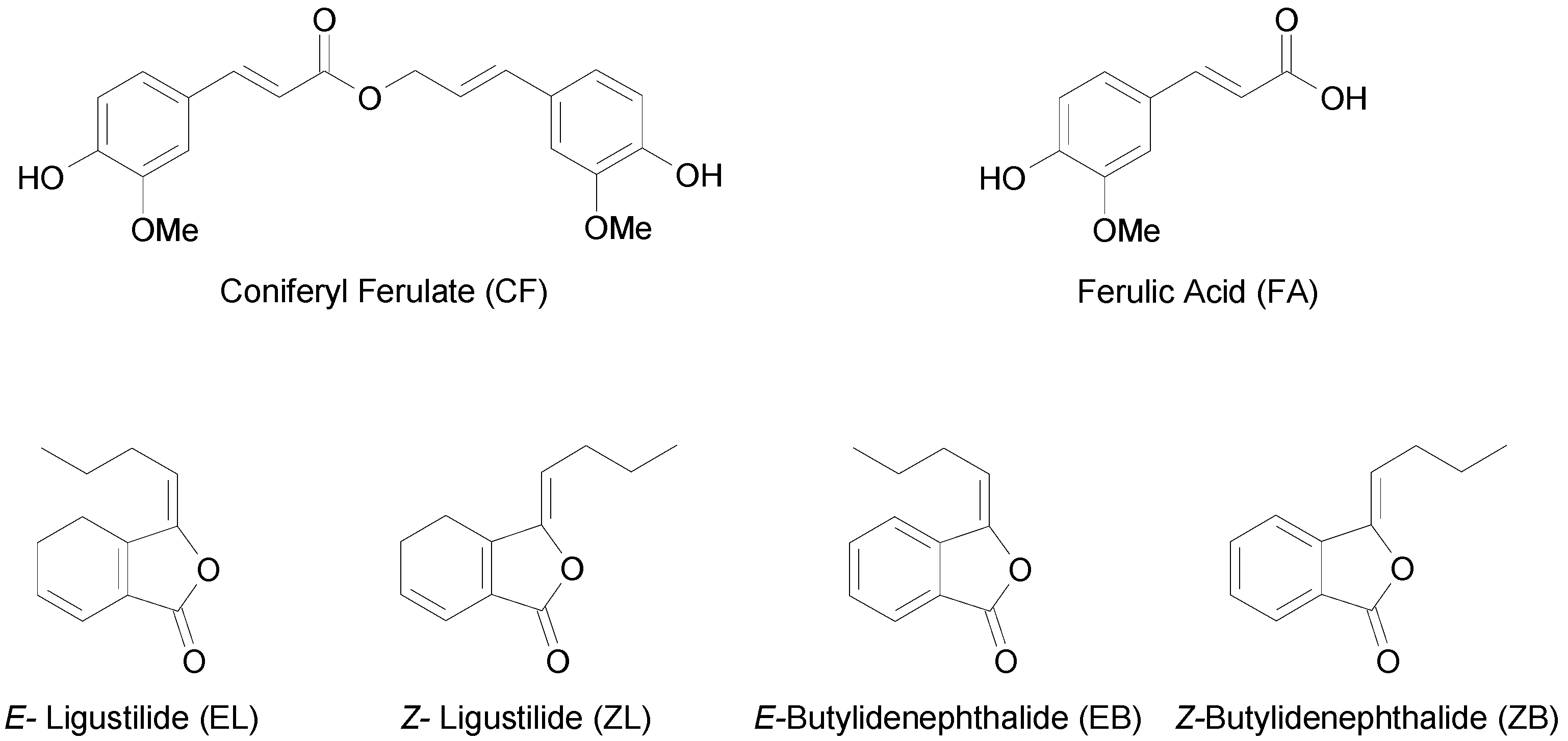
Results and Discussion
Optimization of sonication extraction
Optimization of SFE
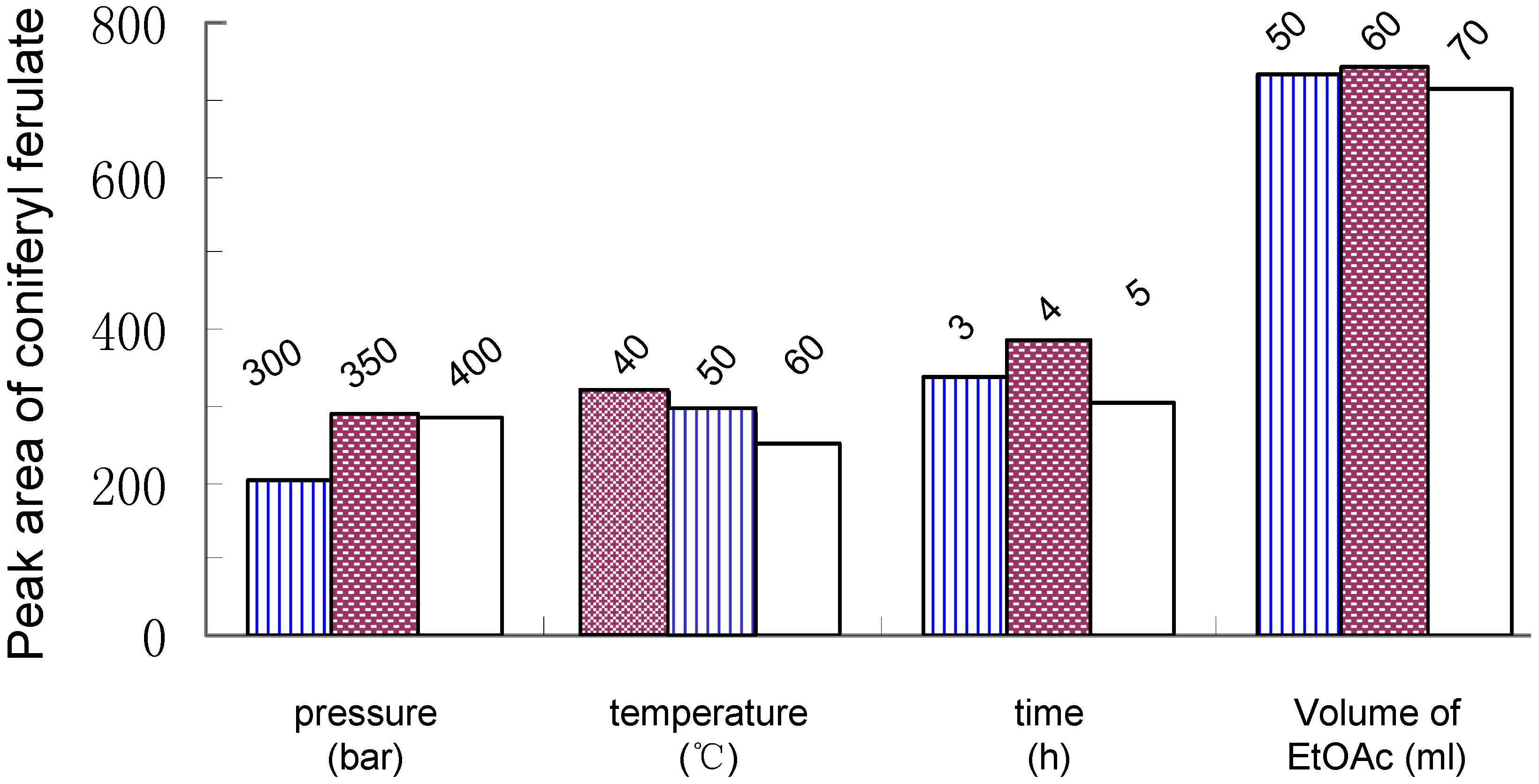
Identification and quantitation of coniferyl ferulate in extracts of A. sinensis
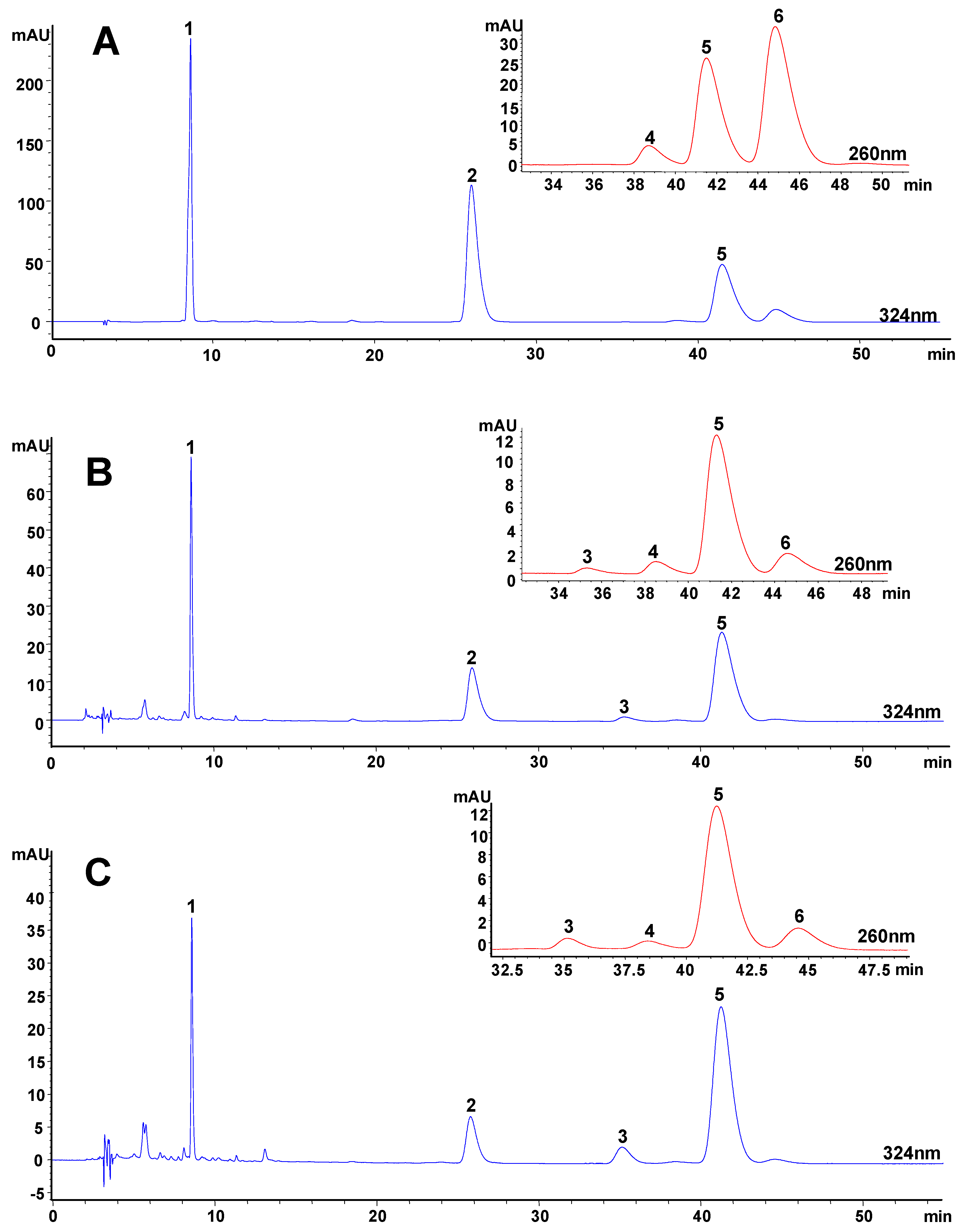
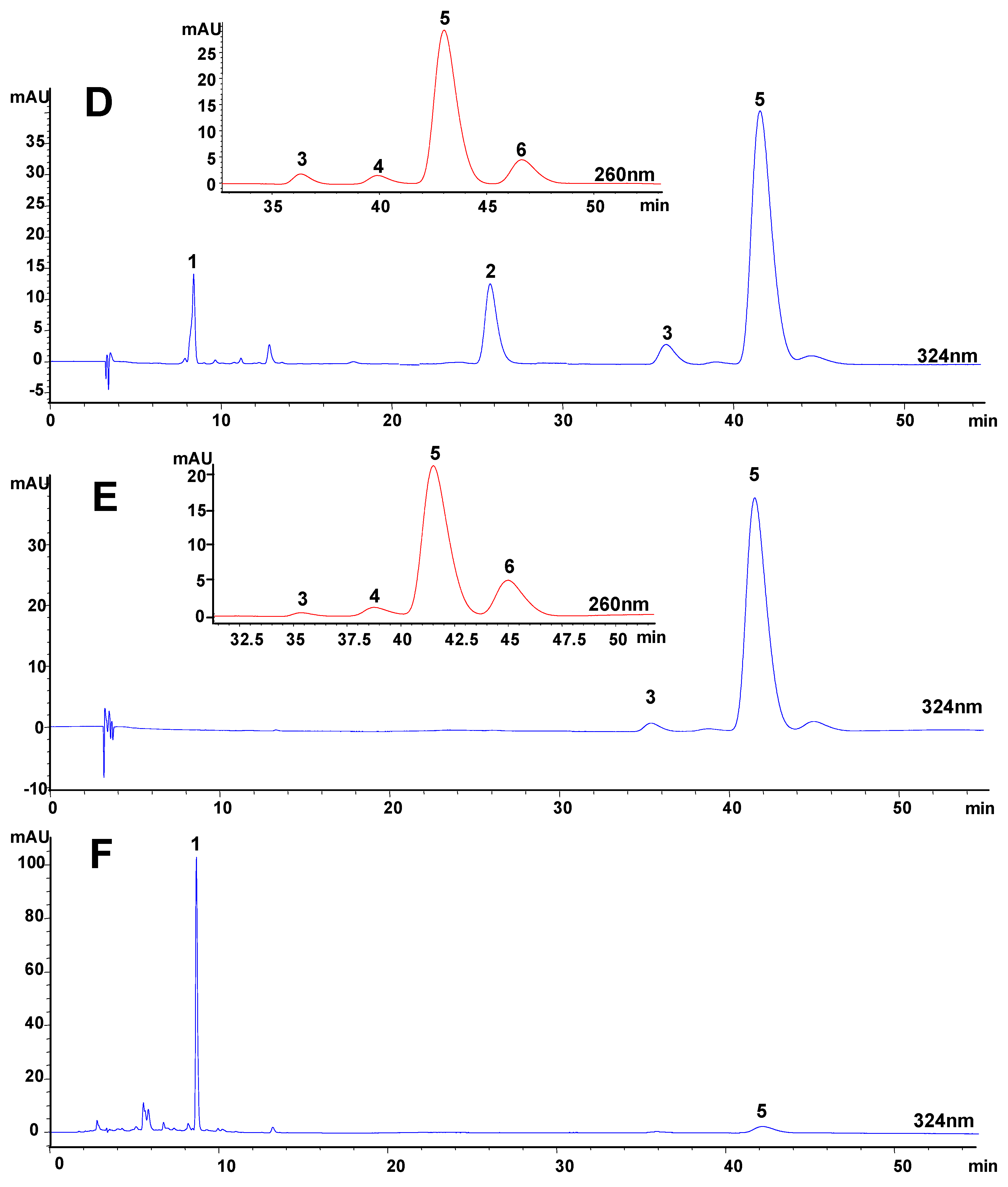
| Methods/Samples | Analytes (mean±SD, n=3) | ||||||
|---|---|---|---|---|---|---|---|
| FA a | CF | E-Lig | E-Bp | Z-lig | Z-Bp | Total | |
| SE | |||||||
| OS b | 0.36±0.01 | 6.11±0.07 | 0.23±0.00 | 0.08±0.00 | 4.34±0.04 | 0.20±0.00 | 11.32 |
| FS | 0.10±0.00 | 20.12±0.47 | 0.84±0.02 | 0.10±0.00 | 11.85±0.23 | 0.10±0.00 | 33.11 |
| PLE | |||||||
| OS | 0.44±0.01 | 6.18±0.19 | 0.51±0.01 | 0.11±0.01 | 6.96±0.13 | 0.22±0.01 | 14.42 |
| FS | 0.17±0.00 | 19.17±0.09 | 0.69±0.01 | 0.12±0.00 | 10.91±0.10 | 0.12±0.00 | 31.18 |
| SFE | |||||||
| OS | 0.14±0.00 | 5.50±0.04 | 0.34±0.01 | 0.07±0.00 | 5.49±0.09 | 0.15±0.01 | 11.69 |
| FS | 0.05±0.00 | 8.65±0.06 | 0.32±0.01 | 0.05±0.00 | 5.63±0.13 | 0.04±0.00 | 14.74 |
| HD | |||||||
| OS | - c | - | 0.04±0.00 | 0.05±0.00 | 3.49±0.10 | 0.14±0.00 | 3.72 |
| FS | - | - | 0.04±0.00 | 0.02±0.00 | 2.60±0.05 | 0.04±0.00 | 2.70 |
| DC | |||||||
| OS | 0.76±0.02 | - | 0.04±0.00 | - | 0.53±0.02 | - | 1.33 |
| FS | 1.04±0.04 | - | 0.08±0.00 | - | 0.55±0.01 | - | 1.67 |
Comparison of the five methods of extraction of coniferyl ferulate from A. sinensis
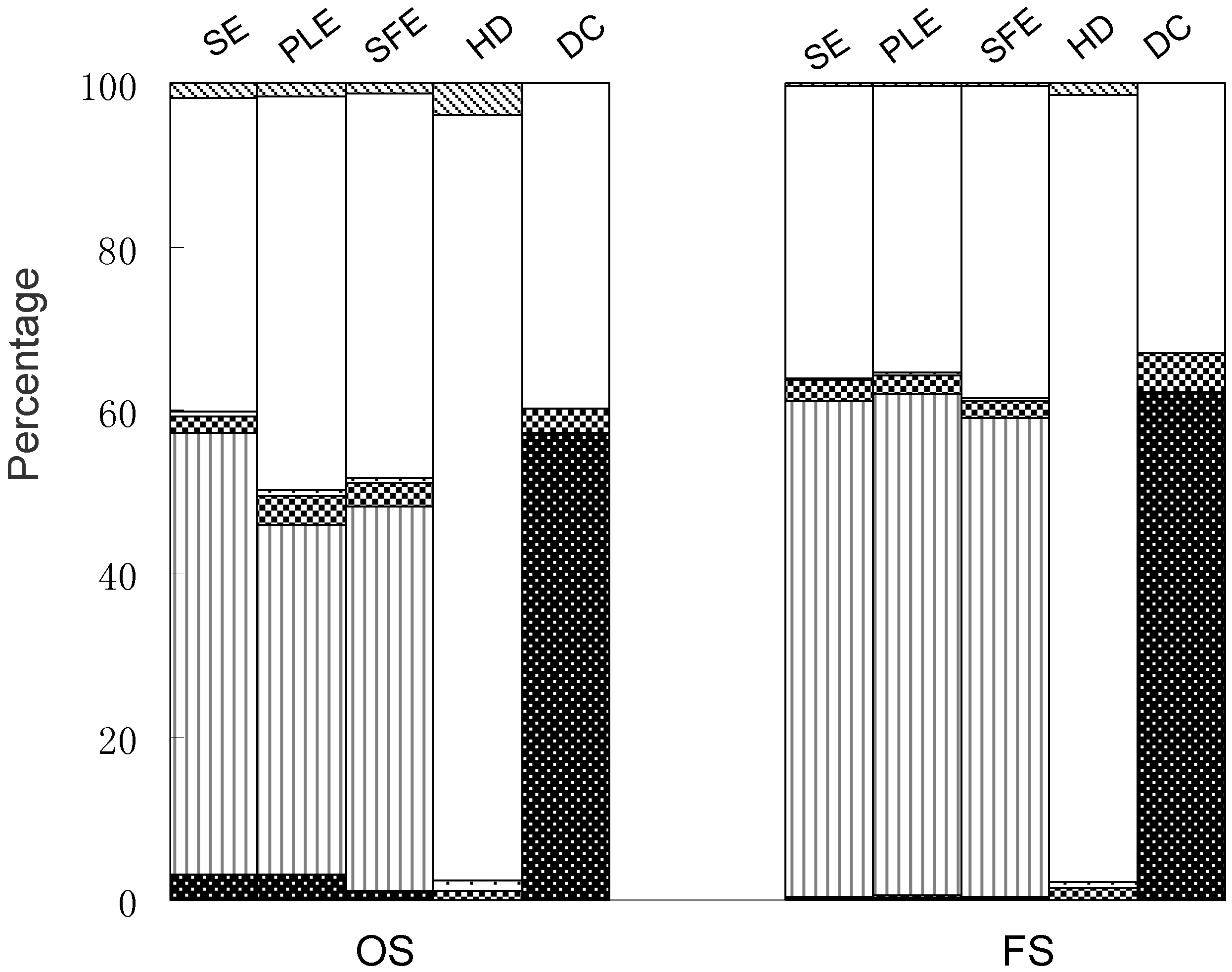
 )Z-butylidenephthalide, (
)Z-butylidenephthalide, (  )Z-Ligustilide, (
)Z-Ligustilide, (  )E-butylidenephthalide, (
)E-butylidenephthalide, (  )E-ligustilide, (
)E-ligustilide, (  )coniferyl ferulate, (
)coniferyl ferulate, (  )ferulic acid.
)ferulic acid.Experimental
Materials
Hydrodistillation
Sonication extraction
Decoction
Supercritical fluid extraction
Pressurized liquid extraction
HPLC analysis
Acknowledgements
References
- Liu, L.N.; Mei, Q.B.; Cheng, J.F.; Li, X. Study on anti-dysmenorrhea effect of essential oil from Angelica sinensis Diels. Jie Fang Jun Yao Xue Xue Bao 2002, 18, 77–79. [Google Scholar]
- Mei, Q.B.; Tao, J.Y.; Cui, B. Advances in the pharmacological studies of Angelica sinensis (Oliv) Diels (Chinese Danggui). Chin. Med. J. 1991, 104, 776–781. [Google Scholar]
- National Committee of Chinese Pharmacopoeia. Pharmacopoeia of the People’s Republic of China; Chemical Industry Press: Beijing, 2005; Volume 1, p. 89. [Google Scholar]
- Hu, H.J.; Hang, B.Q.; Wang, P.S. Anti-inflammatory effect of Radix Angelicae Sinensis. Zhong Guo Zhong Yao Za Zhi 1991, 16, 684–688. [Google Scholar]
- Wu, S.J.; Ng, L.T.; Lin, C.C. Antioxidant activities of some common ingredients of traditional Chinese medicine, Angelica sinensis, Lycium barbarum and Poria coco. Phytother. Res. 2004, 18, 1008–1012. [Google Scholar] [CrossRef]
- Yang, T.H.; Jia, M.; Meng, J.; Wu, H.; Mei, Q.B. Immunomodulatory activity of polysaccharide isolated from Angelica Sinensis. Int. J. Biol. Macromol. 2006, 39, 179–184. [Google Scholar] [CrossRef]
- Huang, W.H.; Song, Q.C. The progress of chemical and pharmacological research on Angelica sinensis. Zhong Guo Zhong Yao Za Zhi 2001, 26, 147–152. [Google Scholar]
- Cao, W.; Li, X.Q.; Liu, L.; Yang, T.H.; Li, C.; Fan, H.T.; Jia, M.; Lv, Z.G.; Mei, Q.B. Structure of an anti-tumor polysaccharide from Angelica sinensis (Oliv.) Diels. Carbohydr. Polym. 2006, 66, 149–159. [Google Scholar] [CrossRef]
- Xia, Q.; Zhang, P.; Li, S.P.; Wang, Y. T. The research on pharmacological effects of Angelica sinensis. Shi Zhen Guo Yi Guo Yao 2004, 15, 164–166. [Google Scholar]
- Lin, L.Z.; He, X.G.; Lian, L.Z.; King, W.; Elliott, J. Liquid chromatographic– electrospray mass spectrometric study of the phthalides of Angelica sinensis and chemical changes of Z-ligustilide. J. Chromatogr. A 1998, 810, 71–79. [Google Scholar] [CrossRef]
- Ou, S.Y.; Bao, H.Y.; Lan, Z.D. The pharmacological research progress of ferulic acid and its derivatives. Zhong Yao Cai 2001, 24, 220–221. [Google Scholar]
- Du, J.R.; Yu, Y.; Yao, Y.; Bai, B.; Zong, X.; Lei, Y.; Wang, C.Y.; Qian, Z.M. Ligustilide reduces phenylephrine induced-aortic tension in vitro but has no effect on systolic pressure in spontaneously hypertensive rats. Am. J. Chin. Med. 2007, 35, 487–496. [Google Scholar] [CrossRef]
- Tao, J.Y.; Ruan, Y.P.; Mei, Q.B.; Liu, S.; Tian, Q.L.; Chen, Y.Z.; Zhang, H.D.; Duan, Z.X. Studies on the antiasthmatic action of ligustilide of Dang-gui, Angelica sinensis (oliv.) diels. Yao Xue Xue Bao 1984, 198, 561–565. [Google Scholar]
- Teng, C.M.; Chen, W.Y.; Ko, W.C.; Ouyang, C. Antiplatelet effect of butylidenephthalide. Biochim. Biophys. Acta 1987, 924, 375–382. [Google Scholar]
- Ou, S.Y. The function and application of ferulic acid. Xian Dai Shi Pin Ke Ji 2002, 18, 50–53. [Google Scholar]
- Lu, G.H.; Chan, K.; Leung, K.; Chan, C.L.; Zhao, Z.Z.; Jiang, Z.H. Assay of free ferulic acid and total ferulic acid for quality assessment of Angelica sinensis. J. Chromatogr. A 2005, 1068, 209–219. [Google Scholar] [CrossRef]
- Zou, H.F.; Kong, L.; Sun, N.H.; Wu, L.H.; Chen, X.G. Use of coniferyl ferulate in anticancer medicine. China Patent 2003101049290, 2005. [Google Scholar]
- Chou, S.C.; Everngam, M.C.; Sturtz, G.; Beck, J.J. Antibacterial activity of components from Lomatium californicum. Phytother. Res. 2006, 20, 153–156. [Google Scholar] [CrossRef]
- Naito, T.; Iketani, Y.; Kubota, K.; Shimoda, Y. Vasodilators containing coniferyl ferulate and phthalide dimers of Cnidium officinale. Jap. Pat. 07233060, 1995. [Google Scholar]
- Li, S.Y.; Yu, Y.; Li, S.P. Identification of antioxidants in essential oil of Radix Angelicae sinensis using HPLC coupled with DAD-MS and ABTS-based assay. J. Agric. Food. Chem. 2007, 55, 3358–3362. [Google Scholar] [CrossRef]
- Kong, L.; Yu, Z.Y.; Bao, Y.M.; Su, X.Y.; Zou, H.F.; Li, X. Screening and analysis of an antineoplastic compound in Rhizoma Chuanxiong by means of in vitro metabolism and HPLC-MS. Anal. Bioanal. Chem. 2006, 386, 264–274. [Google Scholar] [CrossRef]
- Yang, F.; Xiao, Y.S.; Zhang, F.F.; Xue, X.Y.; Xu, Q.; Liang, X.M. High performance liquid chromatography-mass spectrometry analysis of Radix Angelica sinensis. Yao Xue Xue Bao 2006, 41, 1078–1083. [Google Scholar]
- Lu, X.H.; Zhang, J.J.; Liang, H.; Zhao, Y.Y. Chemical Constituents of Angelica sinensis. Chin. J. Pharm. Sci. 2004, 13, 1–3. [Google Scholar]
- National Committee of Chinese Pharmacopoeia. Pharmacopoeia of the People’s Republic of China; Chemical Industry Press: Beijing, 2005; Volume 1, p. XD57. [Google Scholar]
- Li, P.; Li, S.P.; Lao, S.C.; Fu, C.M.; Kan, K.K.W.; Wang, Y.T. Optimization of pressurized liquid extraction for Z-ligustilide, Z-butylidenephthalide and ferulic acid in Angelica sinensis. J. Pharm. Biomed. Anal. 2006, 40, 1073–1079. [Google Scholar] [CrossRef]
- Lao, S.C.; Li, S.P.; Kan, K.K.W.; Li, P.; Wan, J.B.; Wang, Y.T.; Dong, T.T.X.; Tsim, K.W.K. Identification and quantification of 13 components in Angelica sinensis (Danggui) by gas chromatography–mass spectrometry coupled with pressurized liquid extraction. Anal. Chim. Acta 2004, 526, 131–137. [Google Scholar] [CrossRef]
- Xie, J.J.; Yu, Y.; Wang, Y.T.; Li, S.P. Simultaneous HPLC determination of 6 components in Angelica sinensis. Yao Wu Fen Xi Za Zhi 2007, 27, 1314–1317. [Google Scholar]
- Sample Availability: Samples of the compounds are available from the authors.
© 2009 by the authors; licensee Molecular Diversity Preservation International, Basel, Switzerland. This article is an open-access article distributed under the terms and conditions of the Creative Commons Attribution license ( http://creativecommons.org/licenses/by/3.0/).
Share and Cite
Xie, J.-J.; Lu, J.; Qian, Z.-M.; Yu, Y.; Duan, J.-A.; Li, S.-P. Optimization and Comparison of Five Methods for Extraction of Coniferyl Ferulate from Angelica sinensis. Molecules 2009, 14, 555-565. https://doi.org/10.3390/molecules14010555
Xie J-J, Lu J, Qian Z-M, Yu Y, Duan J-A, Li S-P. Optimization and Comparison of Five Methods for Extraction of Coniferyl Ferulate from Angelica sinensis. Molecules. 2009; 14(1):555-565. https://doi.org/10.3390/molecules14010555
Chicago/Turabian StyleXie, Jing-Jing, Jia Lu, Zheng-Ming Qian, Yue Yu, Jin-Ao Duan, and Shao-Ping Li. 2009. "Optimization and Comparison of Five Methods for Extraction of Coniferyl Ferulate from Angelica sinensis" Molecules 14, no. 1: 555-565. https://doi.org/10.3390/molecules14010555




